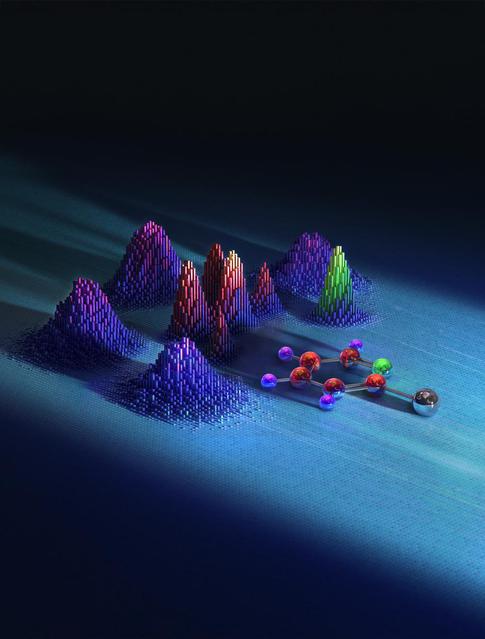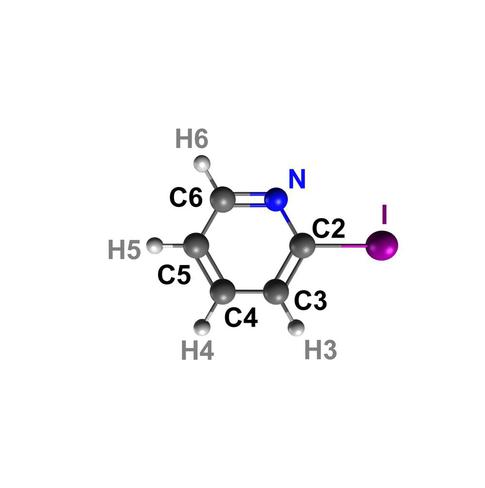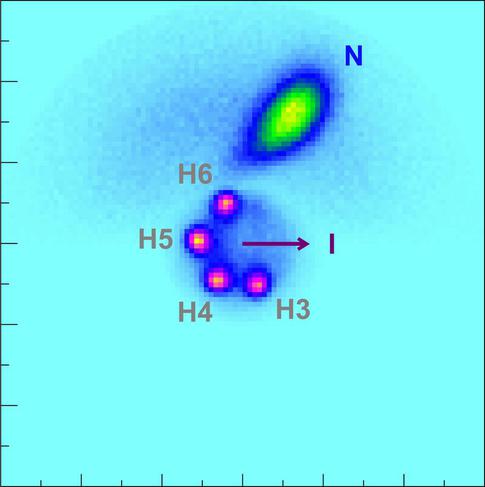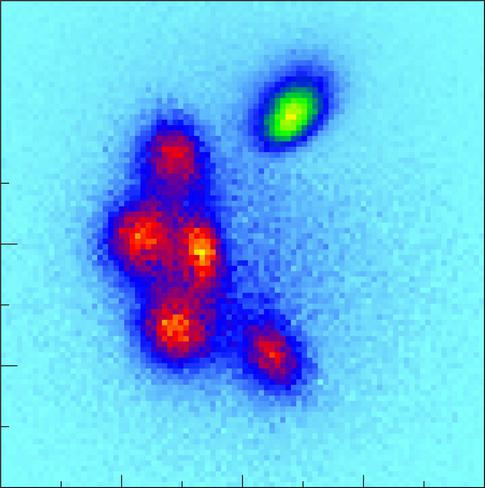XFEL: Molecule snapshot by explosion
Molecule snapshot by explosion

Scientists use X-rays to trigger a violent explosion of single molecules. From the fragmentation pattern they infer detailed information on the molecule and its fragmentation. Copyright: illustratoren.de/TobiasWuestefeld in cooperation with European XFEL

The ring is formed by carbon atoms (grey) and a nitrogen atom (blue). The iodine atom (violet) is on the outside of the ring. Copyright: European XFEL / Rebecca Boll, Till Jahnke
The images are an important step towards recording molecular movies, which researchers hope to use in the future to observe details of biochemical and chemical reactions or physical changes at high resolution. Such films are expected to stimulate developments in various fields of research. “The method we use is particularly promising for investigating photochemical processes,” explains Till Jahnke from the European XFEL and the Goethe University Frankfurt, who is a member of the core team conducting the study. Such processes in which chemical reactions are triggered by light are of great importance both in the laboratory and in nature, for example in photosynthesis and in visual processes in the eye. “The development of molecular movies is fundamental research,” Jahnke explains, hoping that “the knowledge gained from them could help us to better understand such processes in the future and develop new ideas for medicine, sustainable energy production and materials research.”

In this Coulomb Explosion Imaging result, the scientists have concentrated on the hydrogen atoms (violet). Here the shape of the ring can be seen better because the hydrogen atoms are the first to be emitted from the molecule due to a charge-up of the ring-atoms. The heavier nitrogen atom is emitted later in the process, when more charge has been accumulated. Accordingly, due to larger repulsion its momentum is larger than that of the hydrogen atoms. Copyright: European XFEL / Rebecca Boll, Till Jahnke
"Up to now, Coulomb explosion imaging was limited to small molecules consisting of no more than five atoms," explains Julia Schäfer from the Center for Free-Electron Laser Science (CFEL) at DESY, the other first author of the study. "With our work, we have broken this limit for this method." Iodopyridine (C5H4IN) consists of eleven atoms.

The Coulomb Explosion Image of the molecule shows in detail the carbon atoms (red) and the nitrogen atom (green). The ring appears distorted because the detector does not register a direct image but the momentum of the fragments from the explosion, i.e., the product of their mass and velocity. The iodine atom is not displayed as it defines the horizonal axis of the momentum space coordinate system. Copyright: European XFEL / Rebecca Boll, Till Jahnke
Coulomb explosion imaging is particularly suitable for tracking very light atoms such as hydrogen in chemical reactions. The technique enables detailed investigations of individual molecules in the gas phase, and is therefore a complementary method for producing molecular movies, alongside those being developed for liquids and solids at other European XFEL instruments.
“We want to understand fundamental photochemical processes in detail. In the gas phase, there is no interference from other molecules or the environment. We can therefore use our technique to study individual, isolated molecules,” says Jahnke. Boll adds: “We are working on investigating molecular dynamics as the next step, so that individual images can be combined into a real molecular movie, and have already conducted the first of these experiments.”
The investigations involved researchers from Universität Hamburg, the Goethe University Frankfurt, the University of Kassel, Jiao Tong University in Shanghai, Kansas State University, the Max Planck Institutes for Medical Research and for Nuclear Physics, the Fritz Haber Institute of the Max Planck Society, the US accelerator laboratory SLAC, the Hamburg cluster of excellence CUI: Advanced Imaging of Matter, the Center for Free-Electron Laser Science at DESY, DESY and the European XFEL.
More pictures: Mediabank - European XFEL
Publication: Rebecca Boll, Julia M. Schäfer, et al. X-ray multiphoton-induced Coulomb explosion images complex single molecules. Nature Physics, 2022, https://www.nature.com/articles/s41567-022-01507-0
Article in Physics Today: Johanna L. Miller, Coulomb-explosion imaging tackles an 11-atom molecule
Further Information:
Professor Till Jahnke
European XFEL and
Institute for Nuclear Physics, Goethe-University Frankfurt
Phone: + 49 (0)69-798 47023 (Secretary)
till.jahnke@xfel.eu
Dr Rebecca Boll
European XFEL
rebecca.boll@xfel.de
